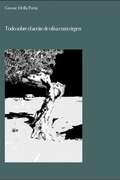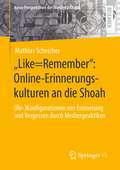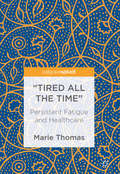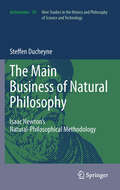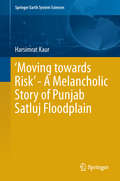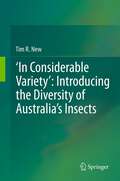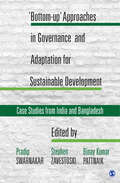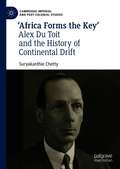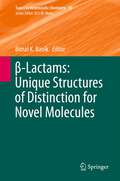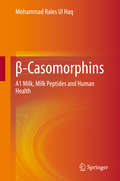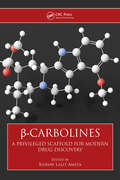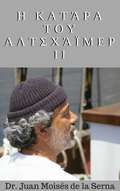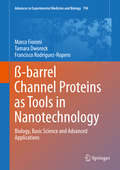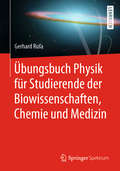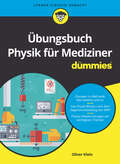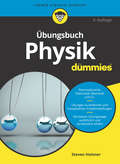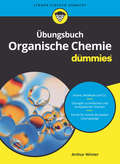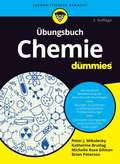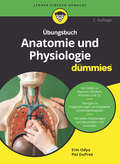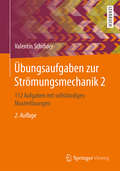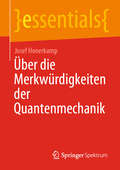- Table View
- List View
オリーブオイルのすべて
by Miyuki Yamamoto Giosue Della Portaエキストラバージンオリーブオイルのすべてが凝縮された一冊 オリーブの歴史から,栽培方法,オイルの生産工程,上質オリーブオイルを選ぶ基準,そして豊富な栄養成分の解説まですべてがわかる 生産基準をクリアしたイタリア産DOP認証オイルを州別に,表と一緒に詳しく説明 シンプルでありながらも,オリーブオイル初心者から,愛好者,専門家にまで役立つ情報がいっぱいです
„Like=Remember“: (Re-)Konfigurationen von Erinnerung und Vergessen durch Medienpraktiken (Neue Perspektiven der Medienästhetik)
by Mathias ScheicherIn diesem Band wird systematisch und theoretisch angeleitet die alltägliche, gesellschaftliche Weitergabe von Wissen über die Shoah durch digitale Praktiken untersucht. Diese stellen die Grundlage für ein innovatives Analysemodell von Online-Erinnerungskulturen dar, das entlang populärer und medienkünstlerischer Beispiele entwickelt wird. Dabei werden Fragen nach nor-mativen Aushandlungen, Formen von Zeugenschaft sowie transnationale digitale Handlungs-routinen aus einer medienwissenschaftlichen Perspektive unter dem Begriff der (Re-)Konfigurationen neu zusammengefasst.
“Tired all the Time”: Persistent Fatigue and Healthcare
by Marie ThomasThis book explores the history, effects, diagnosis and treatment of chronic fatigue as well its significant links to other illnesses. Fatigue is a difficult symptom to accurately assess and quantify due to its subjective nature. Marie Thomas discusses the uncertainties and difficulties in its diagnosis as well as the broader effects of fatigue on quality of life. Fatigue is an increasingly reported problem in primary care, and one that is associated with other chronic conditions as a secondary symptom. Using several case studies, this book describes how in many cases, a patient’s primary condition can be managed; however General Practitioners are left unable to address the fatigue experienced, especially in older adults. Chapters consider the interventions that exist to manage fatigue – especially in the case of Chronic Fatigue Syndrome (CFS) – before highlighting the lack of strategies in primary care for dealing with the problem. In the final chapter Thomas discusses potential interventions and gives recommendations for future research regarding fatigue. This book will be of interest to academics and practitioners in healthcare and psychology, as well as to patient groups and those who care for individuals with fatigue.
“The main Business of natural Philosophy”: Isaac Newton’s Natural-Philosophical Methodology (Archimedes #29)
by Steffen DucheyneIn this monograph, Steffen Ducheyne provides a historically detailed and systematically rich explication of Newton's methodology. Throughout the pages of this book, it will be shown that Newton developed a complex natural-philosophical methodology which encompasses procedures to minimize inductive risk during the process of theory formation and which, thereby, surpasses a standard hypothetico-deductive methodological setting. Accordingly, it will be highlighted that the so-called 'Newtonian Revolution' was not restricted to the empirical and theoretical dimensions of science, but applied equally to the methodological dimension of science. Furthermore, it will be documented that Newton's methodology was far from static and that it developed alongside with his scientific work. Attention will be paid not only to the successes of Newton's innovative methodology, but equally to its tensions and limitations. Based on a thorough study of Newton's extant manuscripts, this monograph will address and contextualize, inter alia, Newton's causal realism, his views on action at a distance and space and time, the status of efficient causation in the /Principia/, the different phases of his methodology, his treatment of force and the constituents of the physico-mathematical models in the context of Book I of the /Principia/, the analytic part of the argument for universal gravitation, the meaning and significance of his regulae philosophandi, the methodological differences between his mechanical and optical work, and, finally, the interplay between Newton's theology and his natural philosophy.
‘Moving towards Risk’ - A Melancholic Story of Punjab Satluj Floodplain (Springer Earth System Sciences)
by Harsimrat KaurThis book explains the tragic tale of the Satluj floodplain since its inception. As a landscape this floodplain entity evolves and sets a niche to distinctive natural and cultural aspects. The historical reconstruction of the landscape transformation depicts the excessive human encroachment and development activities which leads to more than fifty percent of landscape transformation. Data set layers were generated in a geospatial environment, with the use of multiscale and multitemporal satellite imageries, empirical field verification, and ancillary data input. An integrated landscape model was hence formed in order to identify the causal links between natural and cultural aspects.The author shows a landscape transformation matrix and change detection maps to explain the spatial trends and patterns of land use and land cover change. Pixel wise land use and land cover gain-loss algorithm were identified and measured for a selected time period. Changing spatial pattern of land cover to land use ratio are explained with underlying local to regional level causes. The author thoroughly explains the satellite image interpretation and related methodology. This book provides the detailed transition journey of landscape conversion from resource rich natural entity to a human dominated ‘hazardscape’. It also explains how the expansion of population and related activities in the close vicinity of an active floodplain accentuates the problem of flood risks and how it affects the human and livestock life and creates economic loss. The author maps and explains the vector and magnitude of increased human pressure on the landscape and its adverse ecological implications, and describes issues with reference to the hazard status of the Punjab Satluj floodplain, including increased flood risk, increased pressure on agricultural land and depletion of resources, loss of biodiversity, qualitative and quantitative loss to surface and sub-surface water, and soil degradation (soil erosion, waterlogging and soil loss).Recommendations are provided with a detailed provision of potential applications with the underlying agenda of further conversion of this ecologically highly vulnerable flood prone ‘hazardscape’ to a Green Habitat. This book consist of two major themes: land use/land cover change and floodplain. The author answers all the geographical questions (what, where, when, why and how) related with both themes and provides an outlook to potential future prospects. The book is targeted at stakeholders, students, researchers and policy makers to optimize their interest and to guide them towards a positive charge in sustainable resource management through suitable and best possible sustainable utilization of landscape.
‘In Considerable Variety’: Introducing The Diversity Of Australia's Insects
by Tim R. NewThe book introduces basic entomology, emphasising perspectives on insect diversity important in conservation assessment and setting priorities for management, as a foundation for managers and others without entomological training or background. It bridges the gap between photographic essays on insect identification and more technical texts, to illustrate and discuss many aspects of taxonomic, ecological and evolutionary diversity in the Australian insect fauna, and its impacts in human life, through outlines of many aspects of insect natural history.
‘Bottom-up’ Approaches in Governance and Adaptation for Sustainable Development: Case Studies from India and Bangladesh
by Pradip Swarnakar, Stephen Zavestoski, Binay Kumar PattnaikThis book analyzes how governance and climate change adaptation - both integral to sustainable development - operate outside the bureaucratic apparatus of the state. It examines ‘top-down’ and ‘bottom-up’ approaches to sustainable development and looks at a possible ‘middle-out’ approach to resolving the challenges to sustainable development. The book also includes case studies from India and Bangladesh, which show that community-level factors such as social and cultural capital are key to the success of sustainable development efforts.
‘Africa Forms the Key’: Alex Du Toit and the History of Continental Drift (Cambridge Imperial and Post-Colonial Studies)
by Suryakanthie ChettyThis book examines the work of prominent South African geologist Alex Du Toit as a means of understanding the debate around continental drift both in segregation-era South Africa and internationally. It contextualises Du Toit’s work within a particularly formative period of South African science, from the paleoanthropological discoveries that sparked debates about the origins of humankind to Jan Smuts’ own theory of holism. Beyond South African scientific discoveries, the book sets Du Toit’s work against a backdrop of ideological struggles over space, both domestically in terms of segregation and nationalism, as well as internationally as South Africa sought to assert its position within the Commonwealth. These debates were embodied by Du Toit’s work on the theory of continental drift, which put Africa – and South Africa – at the centre geologically and geographically. The author also focuses on the divisions in geology caused by drift theory, tracing the vigorous intellectual debate and dissent indicative of the ideological milieu within which scientific thought is constructed. It traces the history of continental drift from its inception in the nineteenth century and later work of Alfred Wegener, which was both elaborated upon and substantiated by Du Toit. The study further focuses on Du Toit’s research on continental drift in South African and South America, and the geological, fossil and climatological evidence used to bolster this theory.
القانون في الطب 2
by ابن سينااعلم أن المرارة كيس معلّق من الكبد إلى ناحية المعدة من طبقة واحدة عصبانية ولها ضمّ إلى الكبد ومجرى فيه يجذب الخلط الرقيق الموافق لها والمرار الأصفر ويتصل هذا المجرى بنفس الكبد والعروق التي فيها يتكون الدم وله هناك شعب كثيرة غائصة وإن كان مدخل عمودها من التقعير والفم ومجرى إلى ناحية المعدة. والأمعاء ترسل فيه إلى ناحيتهما فضل الصفراء على ما ذكرناه في الكتاب الأول. وهذا المجرى يتصل أكثر شعبه بالاثني عشري وربما اتصل شيء صغير منه بأسفل المعدة وربما وقع الأمر بالضد فصار الأكبر المتصل بالوعاء الأغلظ إلى أسفل المعدة والأصغر إلى الاثني عشري. وفي أكثر الناس هو مجرى واحد متصل بالاثني عشري. وأما مدخل الأنبوبة المصاصة للمرارة في المرارة فقريب من مدخل أنبوبة المثانة في المثانة. ومن عادة الأطباء الأقدمين أن يسموا المرار الكيس الأصغر كما أنه من عادتهم أن يسموا المثانة الكيس الأكبر ومن المنافع في خلقة المرارة تنقية الكبد من الفضل الرغوي وأيضاً تسخينها كالوقود تحت القدر وأيضاً تلطيف الدم وتحليل الفضول وأيضاً تحريك البراز وتنظيف الأمعاء وشدّ ما يسترخي من العضل حوله وإنما لم يخلق في الأكثر للمرارة سبيل إلى المعدة لتغسل رطوباتها بالمرة كما تغسل بها في رطوبات الأمعاء لأن المعدة تتأذى بذلك وتغثّي ويفسد الهضم فيها بما يخالط الغذاء من خلط رديء ويأتيها من العرق الضارب. وللعصبة التي تتصل بالكبد شعبتان صغيرتان جداً والمرارة كالمثانة طبقة واحدة مؤلفة من أصناف الليف الثلاثة وإذا لم تجذب المرارة المرار أو جذبت فلم تستنق عنه حدثت آفات فإن الصفراء إذا احتبست فوق المرارة أو رمت الكبد وأورثت اليرقان وربما عفنت وأحدثت حميات رديئة. وإذا سالت إلى أعضاء البول بإفراط قرحت وإذا سالت إلى عضو ما أحدثت الحمرة والنملة وإذا دبت في البدن كله ساكنة غير هائجة أحدثت اليرقان وإذا سالت عن المرارة إلى الأمعاء بإفراط أورثت الإسهال المراري والسحج.
β-Lactams: Unique Structures of Distinction for Novel Molecules
by Bimal K. BanikI. Ojima * E. S. Zuniga * J. D. Seitz: Advances in the Use of Enantiopure β-Lactams for the Synthesis of Biologically Active Compounds of Medicinal Interests.- I. Fernández * Miguel A. Sierra: β -Lactams from Fischer Carbene Complexes: Scope, Limitations, and Reaction Mechanism.- Bablee Mandal * Basudeb Basu: Synthesis of β-Lactams Through Alkyne-Nitrone Cycloadditions.- T. T. Tidwell: Preparation of Bis-β-Lactams by Ketene-Imine Cycloadditions.- Edward Turos: The Chemistry and Biology of N-Thiolated β-Lactams.- Indrani Banik * Bimal K. Banik: Synthesis of β-Lactams and Their Chemical Manipulations Via Microwave-Induced Reactions.
β-Casomorphins: A1 Milk, Milk Peptides and Human Health
by Mohammad Raies Ul HaqThis book compiles the latest research on the A1 and A2 forms of cow milk, and attempts to show a correlation between the type of cow milk consumption and reported incidence of certain diseases (type 1 diabetes mellitus, cardiovascular diseases, sudden infant death syndrome and neurological disorders). Cow milk generally contains two types of β-casein, A1 or A2. The book describes the A1/A2 hypothesis, its foundation and the genetics behind it. It discusses the two forms of milk and why one is considered more harmful than the other. Seeking to provide a balanced view of the milk types, the book’s initial chapters highlight the structure, function and physiological activity of β-casomorphins. Subsequent sections describe the health concerns associated with A1 milk, and the various case studies and research surrounding it. In turn, the arguments against the hypothesis put forward by EFSA, American Nutritionists and Truswell are also highlighted. The book does not make any recommendations for dairy consumers; rather, it is a collection of essential data both in favour and against the hypothesis. Further mechanistic studies involving well-designed animal and human trials at the cellular, molecular, biochemical and immunological levels will be needed in order to draw sound conclusions. Overall, the hypothesis is fascinating, and possibly significant. However, verified and authenticated research with reproducible results is needed to make final consumer recommendations. This timely book offers a valuable resource for researchers and students of dairy science, as well as industry experts.
β-Carbolines: A Privileged Scaffold for Modern Drug Discovery
by Keshav Lalit Ametaβ-Carbolines: A Privileged Scaffold for Modern Drug Discovery provides a summary of methods for the synthesis of various natural products engineered with the diverse β-carboline scaffold and their biological evaluation.β-carboline and its derivatives have generated considerable interest in recent years for their versatile properties in chemistry and pharmacology. This is due to their ability to act as agonists to benzodiazepine receptors, hydroxy serotonin receptors, and intercalate into DNA and to inhibit CDK, topisomerase, and monoamine oxidase enzymes. Their pharmacological properties include anxiolytic, hypnotic, anticonvulsant, antiviral, antiparasitic, and antimicrobial attributes. This book provides a summary of methods for the synthesis of various natural products engineered with the diverse β-carboline scaffold and their biological evaluation.Features: Focuses on the different application and therapies of β-carbolines. Provides a summary of methods for the synthesis of various natural products engineered with the diverse β-carbolines. Discusses methods of biological evaluation of β-carbolines. Explores different chemical transformations occurring with synthesis using β-carbolines. Covers both heterocyclic synthesis and multicomponent synthesis related to β-carboline. This text is key reading for researchers in medicinal chemistry and drug discovery looking to understand the broad potential of β-carbolines.
Η Κατάρα του Αλτσχάϊμερ ΙΙ
by Juan Moises de la Serna Konstantinos MouratisΤι συμπώματα προκαλεί; Πώς γίνεται η διάγνωση; Πόσα άτομα έχουν νοσήσει; Μάθε για τις τελευταίες έρευνες σχετικά με την ασθένεια του Άλτσχάϊμερ. Κάθε μέρα πραγματοποιούνται νέες ανακαλύψεις για τη νόσο του Αλτσχάϊμερ αλλά αυτές δεν γίνονται γνωστές παρά μόνο στους ειδικούς και στους ενδιαφερόμενους γιατρούς. Αυτό το βιβλίο στοχεύει στο να ξεπεραστεί αυτό το πρόβλημα και να γίνει γνωστή η πρόοδος που έχει επιτευχθεί σχετικά με το Αλτσχάϊμερ.
ß-barrel Channel Proteins as Tools in Nanotechnology
by Marco Fioroni Tamara Dworeck Francisco Rodriguez-Roperoß-barrel outer membrane channel proteins (OMP) are useful as robust and flexible models or components in nanotechnology. Over the last decade biotechnological techniques allowed to expand the natural characteristics of OMPs by modifying their geometry and properties. The present book is oriented towards a broad group of readers including graduate students and advanced researchers. It gives a general introduction to the field of OMP based nano-component development as well as the state of the art of the involved research. On the example of the E. coli FhuA the transformation of an OMP into a tailored nano-channel will be outlined. An exhaustive description of the scientific strategy, including protein selection, analytical methods and "in-silico" tools to support the planning of protein modifications for a targeted application, consideration on the production of a custom made OMP, and an overview on technological applications including membrane/polymersome technology, will be provided.
Übungsbuch Physik für Studierende der Biowissenschaften, Chemie und Medizin
by Gerhard RufaDieses Übungsbuch enthält zahlreiche Aufgaben zum Inhalt einer Einführungsvorlesung Physik. Mithilfe von ausführlichen Lösungen und Erklärungen lernen und üben Studierende die Anwendung physikalischer Rechenmethoden und die hierfür erforderliche Mathematik. Vor allem in Kombination mit dem Lehrbuch Physik für Studierende der Biowissenschaften, Chemie und Medizin bildet es eine ideale Basis für die Klausurvorbereitung und weiterführende Vorlesungen.Der erste Teil des Buches bietet Übungsserien mit Aufgaben, die entsprechend dem Inhalt typischer Physikvorlesungen strukturiert sind und dabei Themen von der klassischen Mechanik bis hin zur Atom- und Quantenphysik abdecken. Jede Übungsserie besteht aus einem Verständnisteil und einem Übungsteil, der durch anwendungsorientierte Aufgaben aus Biowissenschaften, Chemie und Medizin ergänzt wird.Das Gelernte kann dann anhand des zweiten Teils überprüft werden, der aus verschiedenen Testserien besteht: Hier sind gemischte Aufgaben aus den jeweiligen Inhalten der zwei Semester enthalten, wie sie auch in Physikklausuren zu finden sind.
Übungsbuch Physik für Mediziner für Dummies (Für Dummies)
by Oliver KleinSeien wir doch ehrlich: Es gibt Fächer, da lernt man stur auswendig. Andere hingegen muss man wirklich verstehen und da braucht es Übung. Physik zählt zu den letzteren. Das mag lästig sein, aber Hilfe naht: Die Übungen in diesem Buch helfen Ihnen beim Verständnis von Mechanik, Thermodynamik, Elektrizitätslehre, Schwingungen und Wellen, Optik und Atomphysik. Knappe Auffrischungsinformationen und zahlreiche Beispiele ermöglichen es Ihnen, passives Wissen wieder zu aktivieren, und so ist dieses Buch für Sie ein hilfreicher Trainer vor Ihrer Physikprüfung.
Übungsbuch Physik für Dummies (Für Dummies)
by Steven HolznerSie wollen ein einziges Buch, das Sie trotzdem perfekt für Ihre Prüfung vorbereitet? Kraft, kinetische Energie, Thermodynamik, Elektrizität sind nach diesem Buch keine Fremdwörter mehr. Im »Übungsbuch Physik für Dummies« finden Sie über 350 Aufgaben, Lösungen und Erklärungen zu den Kerngebieten der Physik. So können Sie Ihr Wissen festigen und die nötige Sicherheit gewinnen im Umgang mit dieser manchmal recht kniffligen Naturwissenschaft.
Übungsbuch Organische Chemie für Dummies (Für Dummies)
by Arthur WinterOrganik-Klausur? Können Sie nachts nicht mehr schlafen? Wer hätte gedacht, dass es der Kohlenstoff ist, aus dem die Träume sind. Aber Rettung naht: Mit diesem Buch können Sie noch einmal schnell die Grundlagen der Organischen Chemie wiederholen und dann üben, üben, üben. Mit Fragen und Antworten zur Lewis-Struktur, zu Alkanen über Alkene und Alkohole können Sie Ihr Können prüfen und nach und nach verbessern. Genauso können Sie auch Ihr Wissen über Stereochemie, Massenspektrometrie und Spektroskopie testen und somit der nächsten Prüfung gelassener entgegensehen.
Übungsbuch Klinisches EEG
by Hubertus Kursawe Isolde Flemming St. Karol KubickiDieser Übungsatlas beinhaltet eine didaktisch aufgearbeitete Sammlung von EEG-Beispielen mit wissenschaftlichen Definitionen und knappen Fallbeschreibungen. Die Inhalte sind unverzichtbarer Bestandteil der Weiterbildungen für Neurologen, Psychiater und Funktionsassistenten im Bereich der klinischen Enzephalographie. Ein breites Spektrum an Kurvenmaterial und wissenschaftlichen Kriterien ermöglicht dem EEG-Lernenden, eigene Befunde zu erheben und zu bewerten. Kurven aus drei Laboren zeigen, dass jeder Interpret eine eigene EEG-Handschrift haben kann: Beispiele mit Provokationsmethoden, epilepsietypischer Aktivität sowie Herden bzw. regionalen Funktionsstörungen helfen die Flexibilität in der Auswertung zu schulen.
Übungsbuch EEG bei Kindern und Jugendlichen: Atlas mit 370 Beispielen
by Hubertus Kursawe Gerhard KurlemannDieser Übungsatlas für Neuropädiater und Neurologen beinhaltet eine didaktisch aufgearbeitete Sammlung von EEG-Beispielen mit wissenschaftlichen Definitionen und knappen Fallbeschreibungen. Das breite Spektrum an Kurvenmaterial reicht vom Neugeborenen bis zum jungen Erwachsenenalter und hilft dem EEG-Lernenden, eigene Befunde zu erheben und zu bewerten.
Übungsbuch Chemie für Mediziner
by Jürgen SchatzDieses Übungsbuch liefert GK-orientierte Inhalte und ist die perfekte Vorbereitung auf das Physikum. Das Konzept hat sich in der Praxis bewährt.
Übungsbuch Chemie für Dummies (Für Dummies)
by Brian Peterson Michelle Rose Gilman Peter J. Mikulecky Katherine BrutlagSich all die Formeln, Funktionen und Regeln der Chemie zu merken ist schon schwierig genug - und dann soll man sie auch noch richtig anwenden. Da hilft nur üben, üben, üben! Das "Übungsbuch Chemie für Dummies" enthält über 250 Übungen zu Einheitenumrechnung, Periodensystem, Stöchiometrie, Säuren und Basen, Thermodynamik, Redoxreaktionen, funktionelllen Gruppen und vielen anderen grundlegenden Fragestellungen der Chemie. Zudem finden Sie zu Beginn eines jeden Themas eine kurze Widerholung der Theorie, bevor es dann an die Praxis geht. Natürlich gibt es auch ausführliche Lösungen zu allen Aufgaben, so gewinnen Sie Sicherheit und können sich zielgerichtet auf die nächste Prüfung vorbereiten.
Übungsbuch Anatomie und Physiologie für Dummies (Für Dummies)
by Erin Odya Pat DuPreeAnatomie und Physiologie sind zwei sehr lernintensive Fächer, und der Schlüssel zum Erfolg heißt: Erst verstehen und dann üben, üben, üben. Nur durch das häufige Wiederholen des Lernstoffs wird das Wissen gefestigt. Erin Odya und Pat Dupree haben in diesem Buch grundlegende Erklärungen und zahlreiche Übungen und Abbildungen zusammengestellt. So erfahren Sie das Wichtigste über Zellen, Muskeln, Knochen, Organe, das Nahrungs- und Nervensystem sowie die Fortpflanzungsorgane. Mit Abbildungen zum Beschriften und Ausmalen sowie über 800 Aufgaben gerüstet, können Sie dann unbesorgt in die nächste Prüfung gehen.
Übungsaufgaben zur Strömungsmechanik 2: 112 Aufgaben mit vollständigen Musterlösungen
by Valentin SchröderDieses Buch bietet in zwei Bänden vielfältige Aufgaben aus der Strömungsmechanik mit ausführlich vorgerechneten Lösungen und ist damit auch eine wertvolle Hilfe bei der Klausurvorbereitung. Es ist als Übungsbuch konzipiert und zielt darauf ab, die Inhalte der Vorlesung Strömungsmechanik anhand zahlreicher Beispiele besser verständlich zu machen. Das Buch wendet sich vor allem an Studierende der Fachbereiche Maschinenbau, Verfahrens- und Umwelttechnik an Fachhochschulen und Universitäten.Auf der Basis der Grundlagenkenntnisse des Fachs erhält der Leser Aufgaben zur Bearbeitung in verschiedenen Schwierigkeitsgraden – von kurzen Rechenübungen bis hin zu komplexen, mehrteiligen Anwendungsaufgaben. Die Übungsbeispiele decken dabei wichtige Anwendungsfälle der Lehrveranstaltung ab. Es wird besonderer Wert auf eine klar formulierte Aufgabenstellung, die verständliche Beschreibung der Vorgehensweise und die schrittweise, vollständige Lösungsfindung gelegt. Prüfungsaufgaben verschiedener Hochschulen sind ebenfalls Bestandteil des Buchs.
Über die Merkwürdigkeiten der Quantenmechanik (essentials)
by Josef HonerkampDie Quantenmechanik ist eine physikalische Theorie für Objekte des Mikrokosmos, also z.B. für Atome oder Elektronen. Sie hat sich bisher bestens bewährt, führt aber dazu, dass wir diesen Objekten Eigenschaften und Relationen zubilligen müssen, die weder mit unserem gesunden Menschenverstand noch mit den Begriffen der klassischen Physik vereinbar sind. Diese Merkwürdigkeiten werden vorgestellt und ihre Bedeutung für unser Erkenntnisvermögen und für ein Weltbild wird diskutiert.
